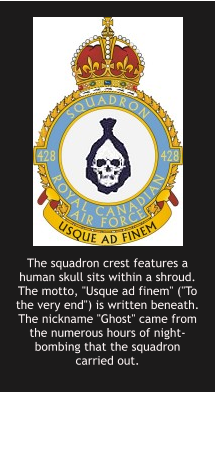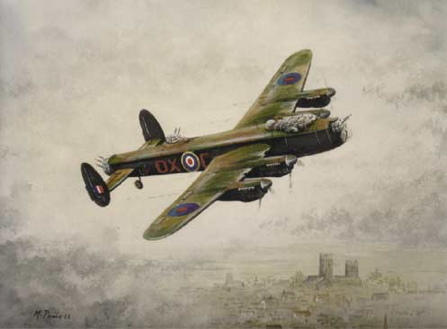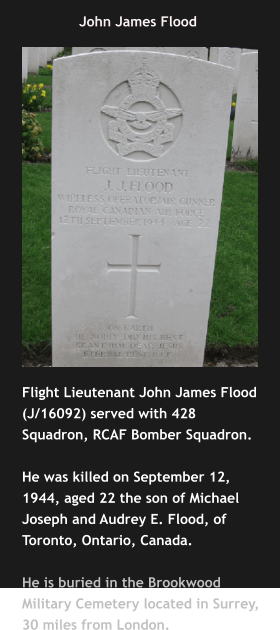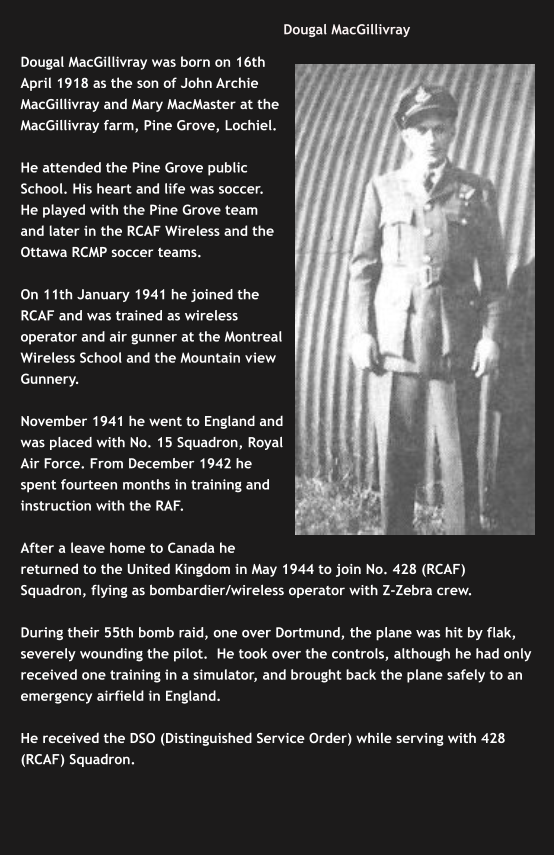
Wartime Heritage
ASSOCIATION


September 12, 1944
“It was a daylight job on Dortmund. We were briefed around one o’clock, and took off around three-
thirty. It was a very clear day, with visibility excellent. On the trip over we didn’t meet any trouble
at all - no fighters, no flak. But when we reached the target and turned in for our bombing run, we
encountered a considerable amount of flak. Being in the latter part of the bombing wave, the flak
was quite heavy for us and from the time we commenced our run until the bombs had gone, we were
being hit”
Flying Officer C. (Charlie) F. Wattie, from Barrie, Ontario, was the Navigator and one of seven crew
members of Z-Zebra, a Lancaster of 428 Squadron, known as the “Ghost Squadron” of the Royal
Canadian Air Force, and part of Bomber Command.
“Well, as mid-upper gunner I get to see almost everything front, back, all round, and it was just like
Charlie said: no fighters, but bags of flak. We got hit all right, in plenty of places. For instance, I
looked out one minute and the tail plane was there, and the next time I looked it was full of holes.
We sure got knocked around.”
Flying Officer R. (Bob) G. Marshall, from Shelbourne, Ontario was the mid-upper gunner. Smitty, Flight Lieutenant H. F. Smith of
Niagara Falls was the wireless operator remembered,
“I was sitting at my set during all this, and the first time I noticed something was really wrong was when the aircraft went into an
upward climb. I jumped to the astro-dome and had a look at things. I saw that ours was the only kite left in the formation.
Mac, Pilot Officer D. A. MacGillivary of Dalkeith, Ontario saw only one thing. The skipper, Lieutenant Russ Curtis, had been hit.
Charlie was the first to reach Lieutenant Russ Curtis. Except for Mac, the rest of the crew didn’t know the skipper had been hit until
they heard his voice on the intercom after they came out of the bombing run. “Well, that’s it” and the crew could tell by the tome of
his voice that he was hurt. Then, the skipper said, “Come up here, Mac”.
Mac, Charlie and Paddy Rose, the flight engineer went up forward. They found the skipper “in pretty bad shape”. He was slumped
over the stick but all the time he was trying to right the position of the aircraft, although he didn’t have much strength left.
Mac, the bomb aimer, although he had never flown before, took over. He had never been at the controls before. He did have about an
hour on a Link trainer once, but that was all. While the skipper was still in his seat, Mac just pointed to the instruments and the
skipper would nod or shake his head and they got the aircraft
corrected back on course. Lieutenant Curtis could hardly see
but got the course set all right.
Paddy and Charlie got the skipper out of his seat. His last words
before he fainted were instructions to Joe on how to trim the
aircraft for level flying. Paddy and Charlie took the skipper down
to the rest position.
“It’s a tough job to move a wounded man in a damaged aircraft”.
They brought the skipper down to a position just behind the
navigator’s table and Bob came down from the upper turret and
helped ease the skipper down the aircraft to the bed, the rest
position. They made him as comfortable as they could, removing
his parachute harness and bandaging up his head.
During this time, no one had heard from Jimmy, the tail gunner.
Charlie called through on the intercom and suggested they check
on Jimmy. Everything had happened so suddenly and they had so much trouble fixing up the skipper and keeping the aircraft in the
air that nobody had had time to think about Jimmy.
Bob Marshall went back to the rear turret and found Jimmy, Flying Officer, John James Flood of Toronto, dead. The flack had got
him. “I’d rather not say anything else about Jimmy. It happens sometimes, and it happened to Jimmy, and we don’t want to talk
about it very much. I came back up through the aircraft and told the rest of the boys and then sat with Russ for the rest of the way.”
Mac took over the controls fully confident that he had the remainder of the crew behind him, and he carried on and flew the aircraft
all the way through the enemy territory and defences, then across the coast to the crash landing drome one of several provided for
use in England when making an emergency landing. They got there and Mac called up on the R.T. At that time he was going in to
make a landing with wheels up. They asked him to go around again. Mac said he would try lowering his undercarriage and come in
the second time with wheels down.
Approaching the runway again, they were cut off by another aircraft making an emergency landing, so Mac had to do a second
overshoot and go around again. Coming in for the third time, everything seemed clear except that still another aircraft was heading
into the runway in the opposite direction. Mac wanted to do another overshoot but Paddy, the flight engineer said they couldn’t do it
and Mac prepared to make a landing.
They touched down and it would have been a perfect three-pointer if the port tire hadn’t blown. Apparently it had been hit by flak
and burst with the second impact. As for Mac at the controls, “Well, someone had to do it. That’s all I can say.”
After they landed and got Lieutenant Russ Curtis, the skipper, off to hospital they reported the whole show and then returned to
their station.
On the night following the day they returned they came down to London to pay their respects to Jimmy Flood. His loss was very
deeply felt by all of the crew and by the many friends he had made on their station. “He was a great boy, Jim Flood. Our present
feelings are a mixture of pride and remorse. We’re very proud of Mac and our engineer and Russ and terribly sorry about Jim. As for
Mac in particular, well, we all had faith in him from the target right back to the emergency field. We prayer for him all the way home
and I think we all knew that we’d make it somehow.”
“Well, our Lanc returned with something like a 150 holes in it. The rear turret and rudders and wings were all very severely
damaged, and our ground crew is going to miss Z-Zebra more than I can tell you. They’re a wonderful bunch, our crew on the
ground, and they’ve given us the best of service right through our second tour of operations. Too bad that our last trip had to be the
way it was, but it could have been worse. We all know that and we’ll all remember and be thankful for the kind of teamwork that
brought us through.”
Charlie, Bob, Mac, and Smitty were of the veteran crew of Z-Zebra (426 Squadron) had served in England, Gibraltar, Malta, West
Africa, Egypt, Palestine and again in England had each flown two tours of operations. As they related this story they had just
completed their second tour the previous week.
[The above story was taken from a script document by Sergeant Marke scheduled for “Eyes Front” and “Calling All Canadians” - Directorate of Public
Relations RCAF Headquarters, London. The document was kindly provided to Wartime Heritage (440 Productions) by the National Air Force Museum of
Canada, CFB Trenton.) Contents copyrighted/used by permission.]
Additional Sources:
http://www.cwgc.org/find-war-dead/casualty/2762660/FLOOD,%20JOHN%20JAMES
http://www.veterans.gc.ca/eng/remembrance/memorials/canadian-virtual-war-memorial/detail/2762660?John%20James%20Flood
http://en.ww2awards.com/person/39689#top
http://acorn2011.com/wp-content/uploads/2010/12/WW2pp-web.pdf




The Crew of Z-Zebra 428 Squadron RCAF (November 12, 1944)
Flight Lieutenant Russ Curtil (DFM) -Pilot
Flying Officer C. (Charlie) F. Wattie - Navigator
Flight Lieutenant H. F. Smith - Wireless Operator
Flying Officer R. (Bob) G. Marshall - Mid-Upper Gunner.
Pilot Officer Dougal A. MacGillivary - Bomb-Aimer
Sergeant Joseph Rose - Flight Engineer
Flying Officer John James Flood - Tail Gunner

copyright © Wartime Heritage Association
Website hosting courtesy of Register.com - a web.com company
Journey Into Germany
Z-Zebra of 428 “Ghost Squadron” RCAF


- World War I - Menu
- WWI Stories and Articles
- Photos - Yarmouth Soldiers
- Selection of World War I Songs
- WWI Casualties of Yarmouth, NS
- Those Who Served - Yarmouth, NS
- WWI Casualties Digby Co. NS
- WWI Casualties Shelburne Co. NS
- Merchant Mariners (1915) Yarmouth, NS
- Canadian Forestry Corps - Non Yarmouth Birth/Residence Enlistments
- US Draft Registry - Yarmouth NS Born


- World War II - Menu
- WWII Stories and Articles
- Telegraphist Air Gunners
- WWII Casualties of Nova Scotia
- US Casualties with NS Connection
- Far East/Pacific Casualties with NS Connection
- Merchant Navy Casualties Nova Scotia
- Nova Scotia WWII Casualties Holten Canadian War Cemetery
- D-Day Casualties - Nova Scotia
- CANLOAN Program Casualties - Nova Scotia
- Battle of the Bulge Casualties - Nova Scotia
- WWII Casualties Yarmouth NS
- Yarmouth Casualties - RCAF RAF Canadian Army WWII
- Yarmouth Co., Marrages WWII
- Casualties Non-Born/Residents with Connection to Yarmouth Co., Nova Scotia.
- WWII Casualties Digby Co., NS
- Non-Nova Scotian WWII Casualties Buried in Nova Scotia
- WWII RCAF Casualties Aged 16-18
- Brothers/Sisters Who Served - World War II













